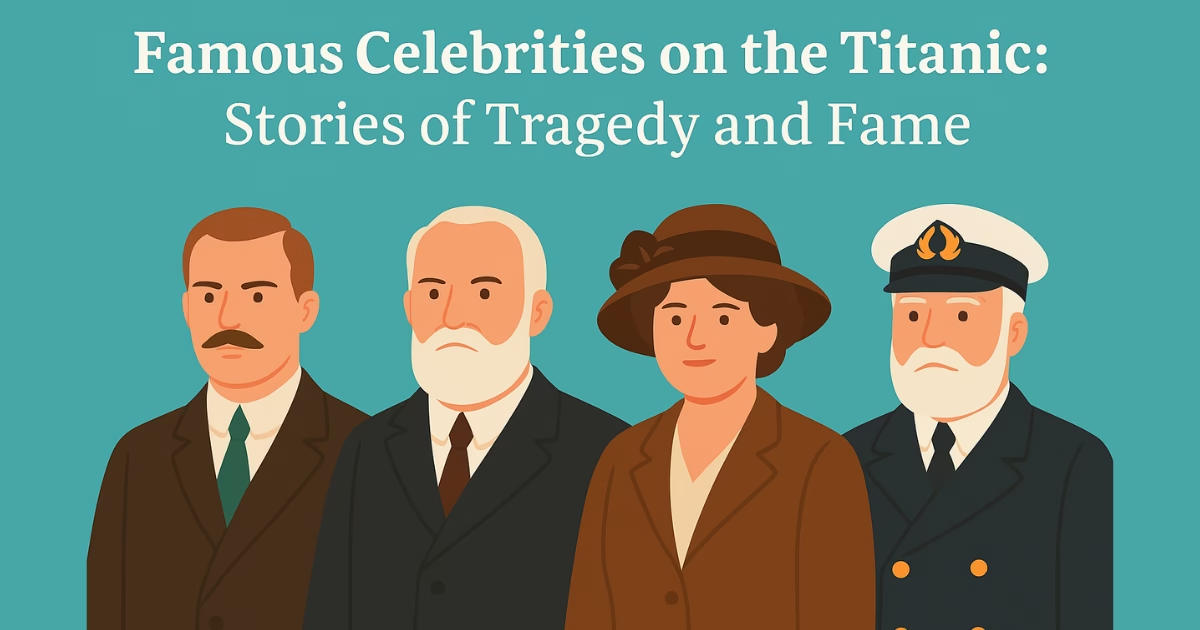The story of the RMS Titanic is one of the most tragic and fascinating in history. A ship deemed “unsinkable,” it met its untimely demise on April 15, 1912, after striking an iceberg during its maiden voyage. While the disaster claimed over 1,500 lives, it also brought attention to the lives of many famous passengers aboard, whose stories have been immortalized. Among them were several celebrities on the Titanic—wealthy industrialists, socialites, and prominent figures from around the world. These individuals, known for their immense wealth and status, became central figures in the tragedy. Their fates, whether tragic or heroic, have captured the public’s imagination for over a century, continuing to fuel documentaries, books, and films. In this article, we explore the stories of these celebrities and the legacies they left behind.
Celebrities on the Titanic: Famous Passengers and Their Legacies
The RMS Titanic was more than just a symbol of technological advancement; it also carried some of the wealthiest and most influential people of its time. Among the passengers were individuals whose names would be forever linked to the ill-fated ship. The celebrities on the Titanic represented a mix of industrialists, socialites, and pioneers of the era. Their stories, filled with both luxury and tragedy, continue to captivate people today.
Some, like John Jacob Astor IV, were wealthy beyond imagination, while others, such as Molly Brown, became symbols of courage and strength. As we delve into the lives of these notable figures, we will explore the personal stories behind their fates and the lasting impact they left on history.
John Jacob Astor IV – The Richest Man on Board
John Jacob Astor IV was a man whose name was synonymous with wealth and power. Born into the famous Astor family, he had amassed a fortune through investments in real estate, railroads, and various industries. By the time he boarded the Titanic, Astor was one of the richest men in the world, with an estimated net worth of around $87 million—equivalent to nearly $2.5 billion today.
Astor was traveling on the Titanic with his 19-year-old wife, Madeleine, whom he had married just a year prior. Despite the age gap, the couple appeared to be deeply in love. Madeleine was pregnant with their child, and they had been looking forward to starting a new life together in America. However, their dreams were shattered on the night of April 15, 1912, when the Titanic struck an iceberg.
Astor did not survive the sinking. He was last seen helping his wife into a lifeboat before he was washed away by the icy waters of the Atlantic. Madeleine survived, but their unborn child did not. Astor’s death, along with his wife’s survival, became one of the most poignant stories of the Titanic disaster. His legacy is not only marked by his wealth but by his tragic end, which epitomized the stark contrast between the opulence of the ship and the brutal reality of the disaster.
Isidor and Ida Straus – A Love Story That Endured
Isidor Straus was a successful businessman, co-owner of the Macy’s department store in New York, and a well-respected figure in the business world. He was traveling aboard the Titanic with his wife, Ida Straus, who was also well known for her social activism and charity work. The Strauses had been married for over 40 years, and their devotion to one another was well known.
When the Titanic struck the iceberg, Isidor and Ida’s fate was sealed. As lifeboats were lowered, Isidor was offered a place in one, but he refused, insisting that a woman take his spot. Ida, determined to stay with her husband, refused to leave him. The couple was last seen standing together on the deck, holding hands. They both perished in the cold waters of the Atlantic, and their love story became one of the most poignant tales from the disaster.
Isidor and Ida Straus became symbols of true devotion, with their story capturing the hearts of many. Their sacrifice and love for each other transcended wealth and status, leaving a legacy that remains a touching reminder of the Titanic’s human tragedy.
Benjamin Guggenheim – The Gentleman Who Died in Style
Benjamin Guggenheim, a wealthy American industrialist, was known for his prominent status in society, as well as his wealth from the Guggenheim family’s mining and smelting businesses. On board the Titanic, Guggenheim was traveling with his mistress, Madame Léontine Aubart. Though not married to her, their relationship was discreet yet well-known in certain social circles.
As the Titanic began to sink, Guggenheim took a calm and dignified approach to his fate. Eyewitnesses report that he famously dressed in his finest clothes, stating, “We are dressed in our best and are prepared to go down like gentlemen.” He then helped others into lifeboats and made sure that his mistress was safe before he ultimately perished. Guggenheim’s actions became symbolic of the Titanic’s final moments: wealth and status could not protect anyone from the icy waters below.
Despite his tragic end, Guggenheim’s legacy lived on. His calm demeanor and sense of dignity in the face of disaster made him one of the most memorable passengers of the Titanic.
Molly Brown – The “Unsinkable” Survivor
Margaret “Molly” Brown, later known as the “Unsinkable Molly Brown,” was one of the most famous passengers on the Titanic. Born into a poor family in Missouri, Molly married a wealthy man, J.J. Brown, and became a prominent socialite in Denver. She was aboard the Titanic in first class, but her true strength came through in the disaster’s aftermath.
As the ship sank, Molly took charge. She helped others into lifeboats and even rowed a lifeboat to safety. When she was rescued, she continued to exhibit courage by helping other survivors and making sure they were treated properly. Her efforts did not go unnoticed, and she soon became a legend, known for her bravery and resilience.
Molly’s story was later popularized in various books, plays, and films, cementing her legacy as one of the Titanic’s most enduring heroes. The title of “Unsinkable” became a symbol of her indomitable spirit and willingness to act in the face of overwhelming odds.
Captain Edward Smith – The Calm Leader
Captain Edward Smith was the man at the helm of the Titanic during its maiden voyage. With decades of experience, Smith was highly respected by both his crew and the passengers aboard the ship. However, his legacy is a subject of much debate. Smith had a reputation for being calm under pressure, yet his decisions on the night of the disaster have been questioned by historians.
As the Titanic struck the iceberg, Smith was reportedly seen trying to maintain order on the ship. He helped direct the crew in the evacuation, but many believe that his delayed response to the iceberg warnings and his decision to continue at full speed in icy waters contributed to the disaster. Smith went down with the ship, as was customary for captains, but his role in the tragedy remains controversial. Some view him as a hero who stayed with his ship until the end, while others criticize his leadership during the crisis.
Despite the criticisms, Captain Smith’s legacy lives on, and his story remains an integral part of the Titanic’s history.
Thomas Andrews – The Designer Who Went Down with the Ship
Thomas Andrews, the chief designer of the Titanic, was another prominent figure who perished in the disaster. He had worked for Harland and Wolff, the shipyard that built the Titanic, and was onboard to observe its maiden voyage. When the ship struck the iceberg, Andrews quickly assessed the damage and began to warn passengers about the severity of the situation.
Unlike many others, Andrews stayed aboard the ship as it sank, assisting passengers and ensuring that as many people as possible made it into lifeboats. In his final moments, he was seen helping women and children, embodying the true spirit of heroism. Andrews did not survive, but his actions made him one of the most respected figures associated with the Titanic disaster.
His story of selflessness and sacrifice has endured, and Thomas Andrews is remembered as a man who gave everything for the safety of others.
The Legacy of the Celebrities on the Titanic
The lives of the celebrities on the Titanic were cut short, but their stories have become an integral part of the ship’s legacy. These figures, ranging from the wealthy Astor and Guggenheim to the courageous Molly Brown and Thomas Andrews, symbolize the human experience of the Titanic disaster—its contrasts between luxury and loss, heroism and tragedy.
Over the years, the Titanic’s story has been retold through books, films, and documentaries. The fates of these famous passengers have become a focal point, with many of their lives forever linked to the ship’s tragic sinking. Their courage, sacrifice, and the way they faced the end of their lives continue to resonate with audiences worldwide.
The story of the Titanic is not just about a ship; it is about the people aboard, their choices, their stories, and the enduring impact they have had on history. The celebrities on the Titanic left behind a lasting legacy, one that will continue to be told for generations to come.
Also Read: Exploring Obscure Flags: Fascinating Symbols from Hidden Nations
Conclusion
The Titanic was not just a ship; it was a microcosm of society in the early 20th century. Aboard it were some of the wealthiest and most influential individuals of the time, whose lives were tragically cut short by a disaster that shocked the world. From John Jacob Astor’s tragic fate to Molly Brown’s heroic survival, the stories of the celebrities on the Titanic are woven into the fabric of history. As we reflect on these figures and their legacies, we are reminded of the fragility of life and the enduring strength of the human spirit in the face of unimaginable disaster.

Hi, I’m Shafy Ali – a curious mind and passionate writer at Celiac Magazine. I cover a little bit of everything, from everyday tips and how-tos to deeper dives into topics that spark conversation. I enjoy turning research into readable, relatable content that informs and inspires. Whatever the subject, I aim to keep it clear, engaging, and genuinely useful.

